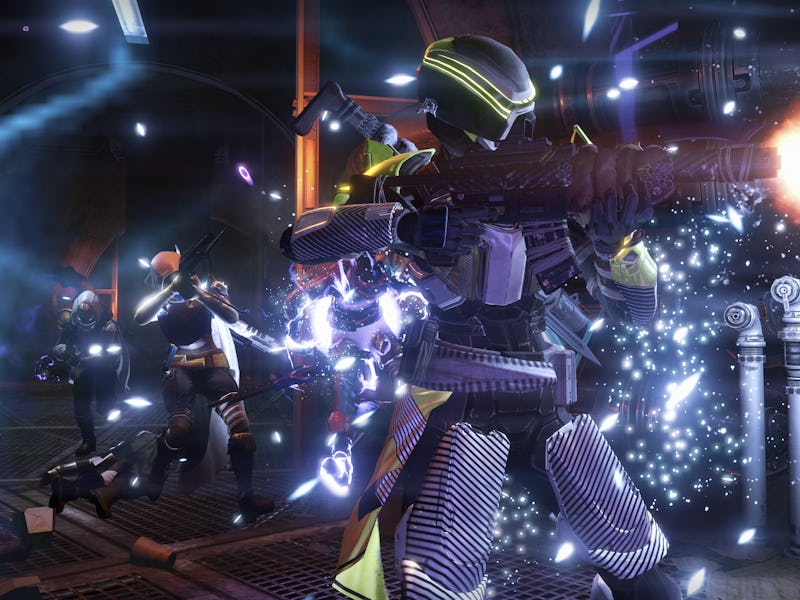The 'Destiny' ARG's the Latest in a Long Line of Experiments
Do you love bees?

“I loves bees.” Any Halo fan knows the significance of that sentence — it represents the Alternate Reality Game (ARG) Bungie used, to great effect, to hype up Halo 2 back in 2004. Last week Bungie launched a new, smaller, but still effective ARG called “Owl Sector” to preclude the latest Destiny expansion, “Rise of Iron,” out September 20. Owl Sector inspired some Reddit topics and a bit of coverage on gaming enthusiast sites — paltry compared with the I Love Bees fervor around Halo 2 — but it proves that Bungie is still the (Taken) king of viral marketing.
An ARG is a form of viral marketing that stretches beyond the medium it’s hyping; i.e., an ARG for a video game might span websites, social media, and commercials in addition to components within the game itself. And ARGs invite and often require player participation, which is what makes them a “game” instead of simply cross-platform marketing.

By all reports, Owl Sector began when some Destiny players who were streaming live on Twitch randomly began receiving previously unknown buffs — or conditions — within the game. The conditions came with names like “Splendor 2.6,” “Brilliance 3.2” and “Glory 2.1,” and these “transmissions” quickly spread to other players. When I logged in on Friday, half the players I encountered seemed to have the telltale “space mites” buzzing around their heads, and my own characters became infected after a couple of multiplayer matches.
Whenever a player who was streaming live became infected, a Twitch user with the name “owl_sector” posted a message in their chat: “We’ve detected an unidentified foreign intrusion into your systems, Guardian. Stay calm. We will investigate.” The message included a link to owlsector.bungie.net, where what appear to be archived logs of conversations between various Destiny characters continuously appeared in the five days leading up to Rise of Iron. The logs detail the discovery of and attempts to quell the spreading infection.
Given that the Rise of Iron expansion concerns the accidental discovery an infectious technology known as SIVA, it was never difficult to see where Owl Sector was going. But crucially, it provided a pretty good reason for some of the many Destiny players who were waiting for Rise to jump back in a few days early and reacquaint themselves with the game. Infected players received a boosted amount of experience, for one thing, and for the Destiny devout, anything that can help ease the game’s infamous grind is exciting.
Players are often referring to the mites as "space AIDS" -- yeah.
Viral marketing campaigns like Owl Sector serve not just to build hype for upcoming releases or lure lapsed players into logging back in; they also bring often tight-knit fan communities even closer together by provide a rallying point for said hype. And few communities are as tight and fervent as Bungie’s, dating back to I Love Bees and Bungie’s very public official seven-step world domination plan.
When Owl Sector kicked off, many of the comments on Reddit and elsewhere amounted essentially to “Oh, a new Bungie ARG. Cool.” But back in 2004, viral marketing was not such a familiar idea, and when Halo fans discovered a web address, ILoveBees.com, hidden in a new Halo 2 trailer, the community took to it eagerly, despite most fans not knowing exactly what they were getting themselves into.
There's no way this guy loves bees.
The campaign, orchestrated by a marketing company called 42 Entertainment, ultimately tasked players around the world with following GPS coordinates to pay phones that would ring at predetermined times, sometimes with live actors on the other end; deciphering complex codes and hidden messages on ILoveBees.com and elsewhere; receiving emails and audio messages with new plot details and cryptic puzzles; discovering the saga of a military artificial intelligence that crash-landed on Earth; and finally visiting movie theaters where they got to play Halo 2 before its retail release. It was completely over the top, but on the other hand, I can’t ever remember being as excited about anything in my life as I was for Halo 2, and I Love Bees was no small factor in that.
Bungie followed that up with Iris, a smaller ARG that led to the release of Halo 3. None of Bungie’s subsequent ARGs have matched the scope of I Love Bees, but it seems the company took an important lesson from that: This type of transmedia viral marketing works really, really well, no matter what the scope. I still get goosebumps whenever I watch the Halo 3 “Believe” ad, which staged potential events from the game as a large-scale, museum-quality diorama, as if future generations would look back on Halo 3 as an important historical event (as they well might).
Destiny is a very different game from Halo. It’s more of a living, breathing, frequently updated world, and as such Bungie can apply that viral strategy to the game itself. Owl Sector didn’t span only Twitch chats, a website, and text logs; it stretched into the game itself. Previous Destiny expansions have featured similar live in-game events in their lead-up, like the new enemy patrols that precluded House of Wolves in April 2015 and the minions of Crota that appeared before the expansion The Dark Below in 2014.
Bungie is a busy studio, working not only on the content currently available in Destiny, but also on expansions like Rise of Iron and sequels like Destiny 2, which is expected in 2017. Clearly a lot of work goes into Owl Sector and similar events. If you’re wondering whether it’s worth it, just ask any longtime Bungie fan: Do you love bees?